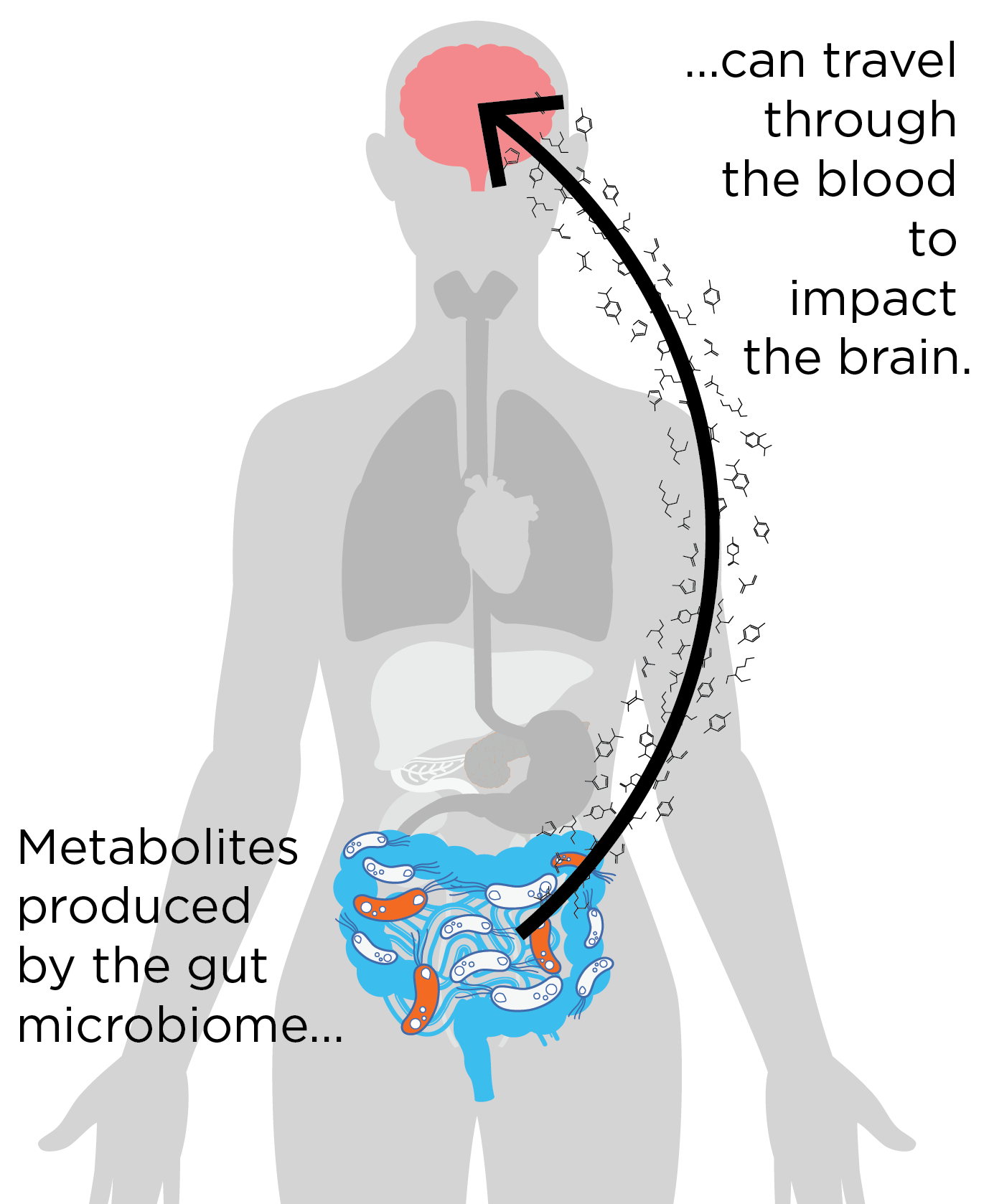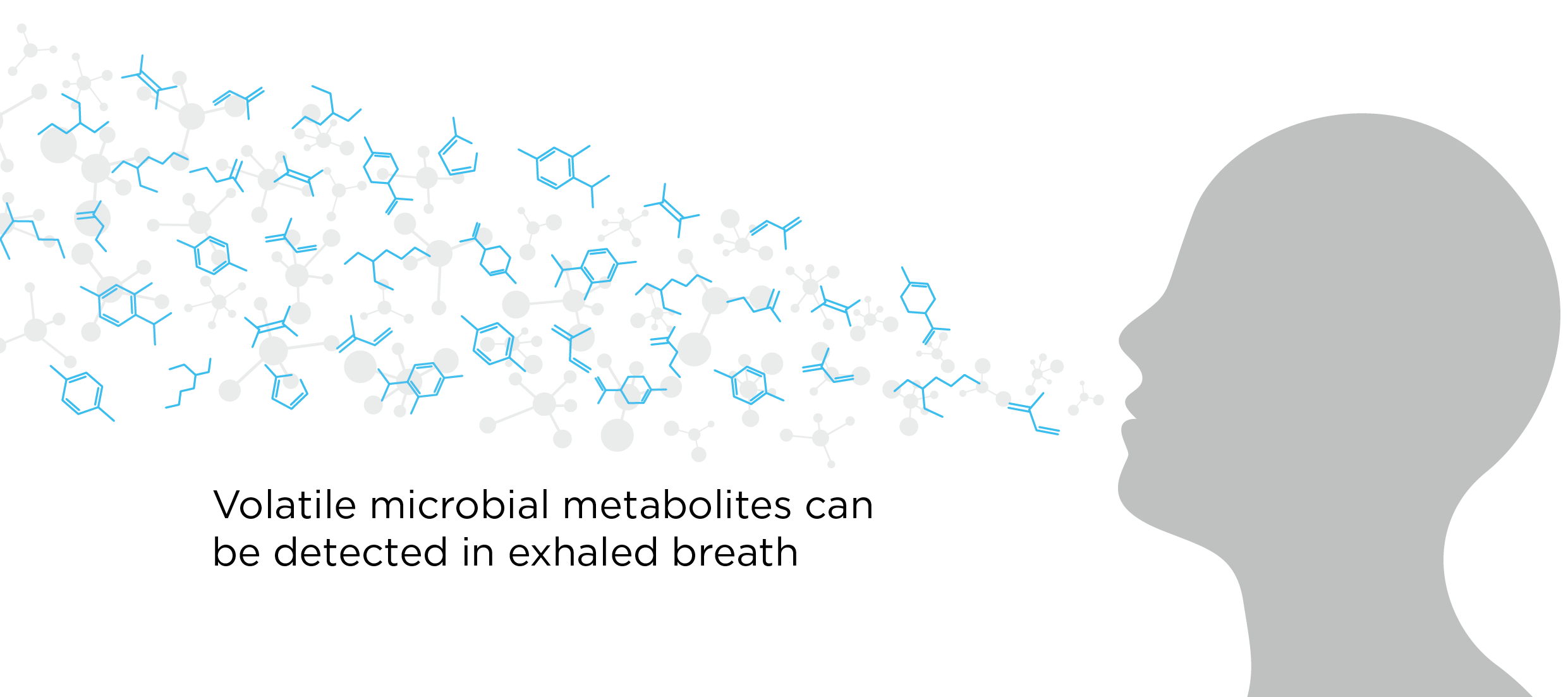Microbial VOCs involved in the gut-brain axis are in the breath
Published on: 21 Aug 2023

The gut-brain axis describes a bidirectional communication between the gut and the brain, bridging our cognition with the activity of the gastrointestinal tract through a complex network of pathways. This connection is intuitive when considering that the stress response in the body, also known as the “fight or flight” response, which causes the muscles of the intestinal tract to change their activity and slow down. The sympathetic branch of the autonomic nervous system is responsible for this response in the body and directly links digestive function to the processes of the brain.
As this link is bidirectional, the processes ongoing in the gut can also affect the brain, particularly the gut microbiome, coining the term “microbiota-gut-brain axis”. The mechanism through which the microbiota in the gut can affect the brain is multifaceted and includes microbial metabolites directly contacting and interacting with the tissues of the brain. As well as being able to synthesize neurotransmitters such as dopamine, other microbially-produced metabolites such as acetate have been shown to cross the blood-brain barrier to be taken up into the brain, potentially having an impact on appetite regulation (1).
This is because metabolites produced in the gut can diffuse from their origin into the nearby blood vessels to travel systemically throughout the body. Many metabolites that the gut microbiota produce are volatile, and therefore can also travel via the blood to the brain, but can also volatilize from the blood into the breath. The vascular surface of the alveoli membrane in the lungs is direct contact point of the inhaled outside air and the systemic blood, where oxygen and carbon dioxide will be exchanged. At this surface, volatile compounds in the blood can volatilize into the air, to be exhaled alongside waste gases.
Due to this connection between the systemic blood and the composition of breath, breath analysis is a platform through which to study volatile microbial metabolites produced in the gut that affect the brain. For example, the previously mentioned acetate is a short-chain fatty acid, a group of volatile metabolites that also includes butyrate and propionate.
A gut microbiota metabolite is associated with altered neurological function.
A recent paper published in Nature by Needham et al. highlighted the impact that a gut-microbiota-derived compound 4-ethylphenylsulfate (4EPS) has on the brain (2). 4EPS has been previously observed to be raised in those with autism spectrum disorder (ASD), as well as in ASD mouse models (3,4). This study created bioengineered gut bacteria to selectively convert 4-ethylphenol (4EP) to 4EPS in mice, which do not usually have detectable levels of 4EPS.
They found that 4EPS entered the brain and resulted in changes to region-specific activity and functional connectivity, specifically disrupting the maturation of oligodendrocytes (the myelinating cells of the central nervous system) and myelination patterns. Normal myelination is crucial for neurological function, and disrupted myelination has been associated with many neurological conditions such as multiple sclerosis, and disruptions in behavior (5–7). The mice in this study with 4EPS produced by their gut microbiota exhibited more anxiety-like behaviors, an effect that was removed by the addition of drugs that restored oligodendrocyte function.
This mechanistically links a microbial metabolite to altered cognition through direct impacts on the brain, and therefore is a major candidate for further study into the gut-brain axis and neurological conditions. It is predicted that in humans the microbiota in the gut community can impact which metabolites are circulating in the body, and could therefore impart an effect on our cognition. 4EPS is generated through the conversion of the dietary compound tyrosine to 4EP by the gut microbiota, which is then sulfonated to 4EPS (8).
The precursor compound 4EP is volatile and readily detectable in exhaled breath, and is one of many compounds in our Breath Biopsy VOC Atlas. The VOC Atlas is a catalog of volatile compounds found in the breath of a heterogenous human population that we have reliably distinguished from background sources. This means that we have robust evidence to back up that this compound has not been inhaled from the environment but is originating from the ongoing metabolic processes ongoing in the body.
Breath analysis can support innovative gut-brain axis study designs.
For gut-brain axis associated compounds such as 4EP, this could include measuring the amounts in the breath of those with neurological and cognitive conditions to make associations with the activity of the gut microbiota. This could also be monitored in response to treatment, including targeted antibiotic therapy designed to remove the species in the gut that are responsible for 4EP metabolism, to see if levels in the breath, and therefore in the blood, are going down, and seeing if this is associated with the improvement of symptoms.
There are many microbially-originated volatile metabolites that can be detected in the breath for inclusion in research. Breath has many unique advantages as a sampling medium that can complement other sampling mediums such as blood, urine, and fecal matter for a multiomic approach. To discuss how we could incorporate breath analysis into your study designs please do not hesitate to contact us, or download our short Breath Analysis and the Microbiome 101 document to find out more information.
References
- Frost G, Sleeth ML, Sahuri-Arisoylu M, Lizarbe B, Cerdan S, Brody L, et al. The short-chain fatty acid acetate reduces appetite via a central homeostatic mechanism. Nat Commun. 2014 Apr 29;5:3611. DOI: 10.1038/ncomms4611.
- Needham BD, Funabashi M, Adame MD, Wang Z, Boktor JC, Haney J, et al. A gut-derived metabolite alters brain activity and anxiety behaviour in mice. Nature. 2022 Feb;602(7898):647–53. DOI: 10.1038/s41586-022-04396-8.
- Needham BD, Adame MD, Serena G, Rose DR, Preston GM, Conrad MC, et al. Plasma and Fecal Metabolite Profiles in Autism Spectrum Disorder. Biological Psychiatry. 2021 Mar 1;89(5):451–62. DOI: 10.1016/j.biopsych.2020.09.025.
- Hsiao EY, McBride SW, Hsien S, Sharon G, Hyde ER, McCue T, et al. Microbiota Modulate Behavioral and Physiological Abnormalities Associated with Neurodevelopmental Disorders. Cell. 2013 Dec 19;155(7):1451–63. DOI: 10.1016/j.cell.2013.11.024.
- Browne P, Chandraratna D, Angood C, Tremlett H, Baker C, Taylor BV, et al. Atlas of Multiple Sclerosis 2013: A growing global problem with widespread inequity. Neurology. 2014 Sep 9;83(11):1022–4. DOI: 10.1212/WNL.0000000000000768.
- Hoban AE, Stilling RM, Ryan FJ, Shanahan F, Dinan TG, Claesson MJ, et al. Regulation of prefrontal cortex myelination by the microbiota. Transl Psychiatry. 2016 Apr 5;6(4):e774. DOI: 10.1038/tp.2016.42.
- Berer K, Mues M, Koutrolos M, Rasbi ZA, Boziki M, Johner C, et al. Commensal microbiota and myelin autoantigen cooperate to trigger autoimmune demyelination. Nature. 2011 Oct 26;479(7374):538–41. DOI: 10.1038/nature10554.
- Gamage N, Barnett A, Hempel N, Duggleby RG, Windmill KF, Martin JL, et al. Human sulfotransferases and their role in chemical metabolism. Toxicol Sci. 2006 Mar;90(1):5–22. DOI: 10.1093/toxsci/kfj061.
Catch up on the presentations from the Breath Biopsy Conference 2024

